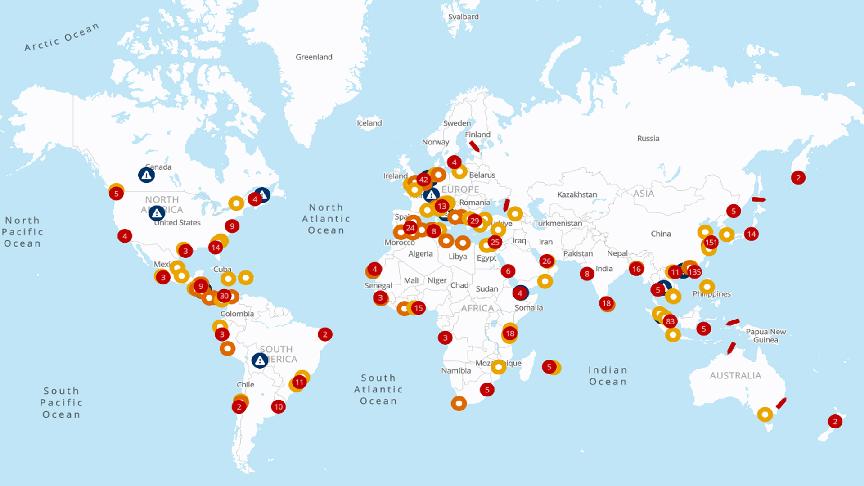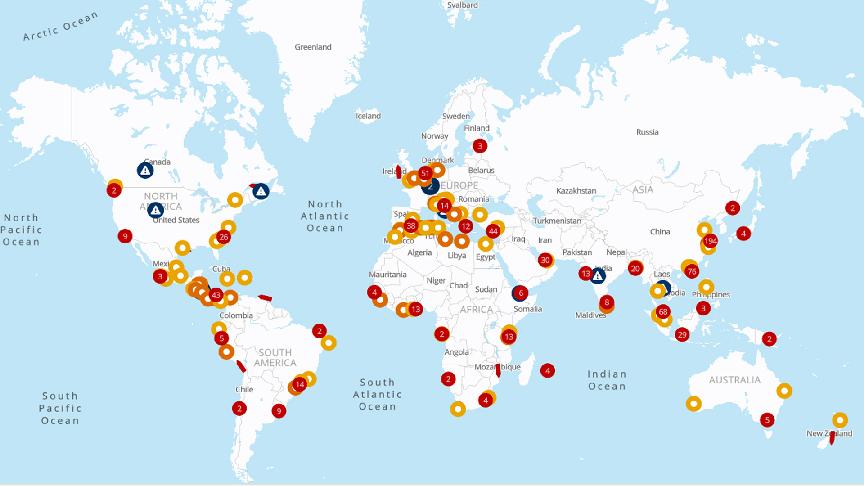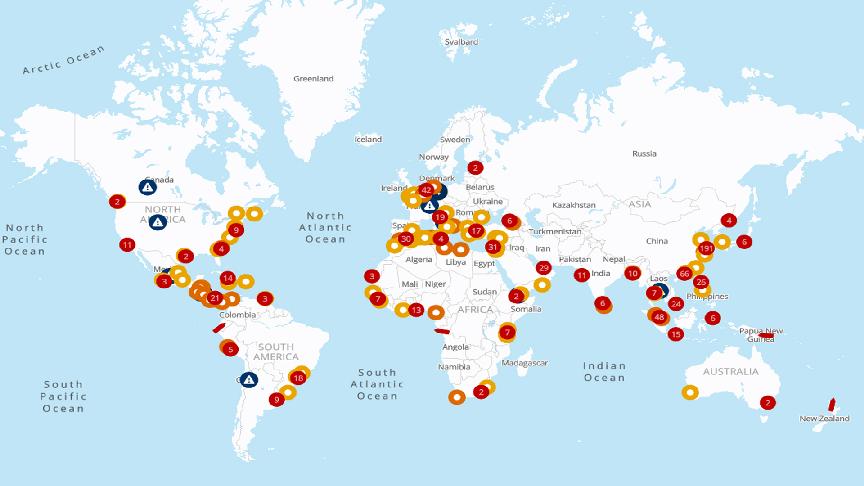- Stay ahead of supply chain disruptions and port congestion with Kuehne+Nagel’s weekly port operational update.
- Find out the latest vessel waiting times and status of ports in Africa, Asia Oceania, Europe, Middle East-Indian Subcontinent, North America, and South and Central America.
Africa
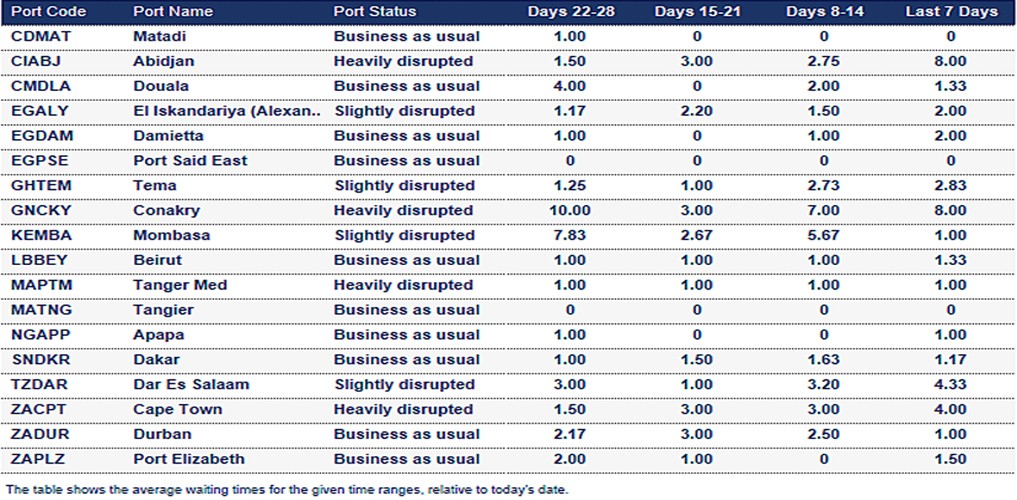
Ghana
Tema: The average vessel waiting time remains around 3 days this week due to the bunching of off-window vessels. Recent power outages have also created a backlog at the port. At the time of publishing, six vessels were waiting to berth.
Guinea
Conakry: Heavy congestion continues in Conakry with a rise in vessel waiting time to 8 days this week.
Ivory Coast
Abidjan: Severe yard congestion is currently impacting operational efficiency and resulting in berthing delays.
South Africa
Cape Town: Waiting time has increased to 4 days this week. Winter weather and strong winds may impact port operations. Vessel delays are also service-dependent.
Durban: The delivery of new equipment has increased productivity in vessel operations, and waiting times have reduced significantly.
On the landside, gate processing is slower, resulting in a buildup in the container yard and slower truck turnarounds. Truckers have also reported issues with the booking system, causing delays.
Bayhead Road construction has not resulted in major challenges for truckers, but congestion may occur at times.
Morocco
Tanger Med: Congestion continues at Tanger Med. At TAT, carriers report waiting times of 5-6 days. The yard is congested due to an increase in discharge volumes from late-arriving vessels. Two vessels were waiting for a berth at the time of publishing
Mauritius
Port Louis: The 7-day average vessel waiting time is around 2 days due to adverse weather conditions.
Kenya
Mombasa: The congestion in Mombasa is expected to continue for the short term. At the time of this publication, four vessels were waiting for a berth.
Tanzania
Dar es Salaam: Berthing delays have increased this week to around 4 days. The terminal gate and road are congested, resulting in further delays. At the time of publishing, nine vessels were at anchor, up from last week's four.
Asia Oceania

Tropical cyclone WIPHA, also known as "Crising" in the Philippines, has significantly disrupted transport across China, the Philippines, and Vietnam. Read more
China
According to seaexplorer, 108 ships are at Shanghai-Ningbo anchorage. Carriers report waiting times of 2-3 days at the Shanghai YS terminal and 1.5-2 days at Shanghai WGQ and Ningbo.
Waiting time can be up to 2 days at Qingdao. At the time of publishing, 19 ships were waiting for a berth.
Malaysia
Port Klang: Vessel bunching and congestion at the berths are causing vessel delays. The yard density is up to 90%. At the time of publishing, 16 vessels were at anchor.
Europe
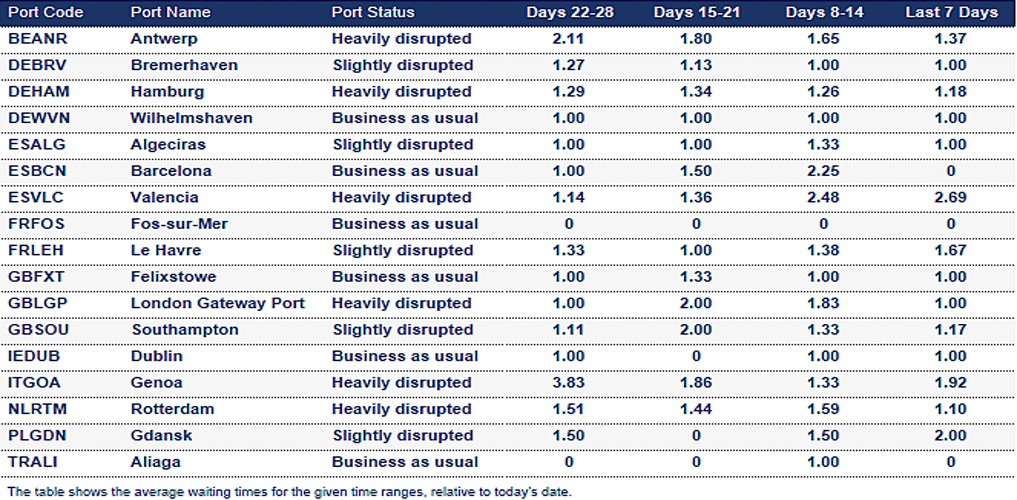
Belgium
Antwerp:
- MEPT: The berthing lineup is busy, and yard density is high. Due to the yard congestion, waiting times for container pickup/dropoff have increased. Labour shortages are expected during the weekends and the summer holiday period.
- Q913: With yard utilisation high and cranes out of service, operations are under pressure at this terminal. Vessel waiting times were between 24-45 hours according to carriers. PSA is working towards reducing delays by limiting the moves to proforma. Additionally, labour shortages are occurring during the weekends.
Germany
Bremerhaven: The yard is around 80%. Due to the vacation period, a labour shortage is anticipated.
Hamburg:
At CTA, CTB, and CTT, berthing lineups are full. Late-arriving vessels are required to wait for a berth at CTT.
Yard utilisation remains high, and therefore, gate-in restrictions remain in place. A labour shortage is expected until September due to the summer holidays.
Several factors are contributing to significant rail delays at all terminals. Construction closures, infrastructure issues, backlogs from previous strikes and increased volumes are contributing to operational delays. The rail delay at CTB was 48 hours at the start of the week and has since been reduced to 24 hours. At EKOM, rail delays are currently 4 hours.
Italy
Bari: The terminal is currently facing severe congestion due to disruptions in the vessel schedule, leading to long queues of truck drivers attempting to collect and deliver units.
Genoa: Some carriers report waiting times of up to 3 days, resulting in port omissions to avoid delays. The yard density is approximately 86%, and labour is tight.
La Spezia: The 7-day average vessel waiting time is around 2.25 days. The yard density is around 80%.
Livorno: The 7-day average vessel waiting time is around 3 days.
Trieste: Congestion at the Port of Trieste is resulting in partial discharge operations and queues at the terminal gate for both unit collection and return.
Netherlands
Rotterdam:
- ECT: No changes to the challenges at this terminal. The berthing line and yards are highly occupied, and late-arriving vessels wait up to 2 days for a berth. The barge and feeder delay was further reduced to 24 hours last week. ITT moves for feeders are restricted. On the landside, there is a high waiting time for truckers at peak hours.
- RWG: Some carriers report that the average waiting time for a berth has increased to 10 days due to full vessels. The high volumes are adding pressure to the yard. There are no gate delays, and truck turnaround times are around 30 minutes.
- MVII: High yard levels; however, operations are stable
Slovenia
Koper: The 7-day average vessel waiting time is around 1.75 days. Container terminal utilisation is at 93%. The cargo surge causes import and export dwell time of 5-6 days. Railway reconstruction until 3Q 2026 reduces train traffic, causing an increase in truck traffic.
Spain
Algeciras: Carriers report a high yard density of around 85% and a full berthing lineup. Vessels can wait up to 1.5 days. TTIA adopts a dynamic berth model prioritising loading-heavy vessels to maintain terminal flow. Empty containers face gate-in restrictions; only trucks with plates starting with 'E' are accepted via EDI/e-service.
Valencia: Due to vessel bunching, the 7-day average vessel waiting time is around 2.69 days. At the time of publishing, 16 vessels were waiting for a berth. Yard density remains exceptionally high at 85%, and customers are asked to pick up containers as soon as possible. The gate is slightly congested.
Turkey
Izmir: The 7-day average vessel waiting time is around 4 days, and yard density is around 80% at DP World.
Mersin: Mainline vessels berth on arrival, while feeders wait approximately 3 days for a berth.
United Kingdom
London Gateway Port: Productivity is currently lower due to recent power and system outages. The berthing line-up remains full, and terminal dredging is ongoing. Late-arriving vessels face waiting times.
Southampton: The berthing lineup is busy, but vessels berth with minimal waiting time. The yard is highly utilised, and truck turnaround times are around 40 minutes. There are no major disruptions at the port.
Middle East - Indian Subcontinent
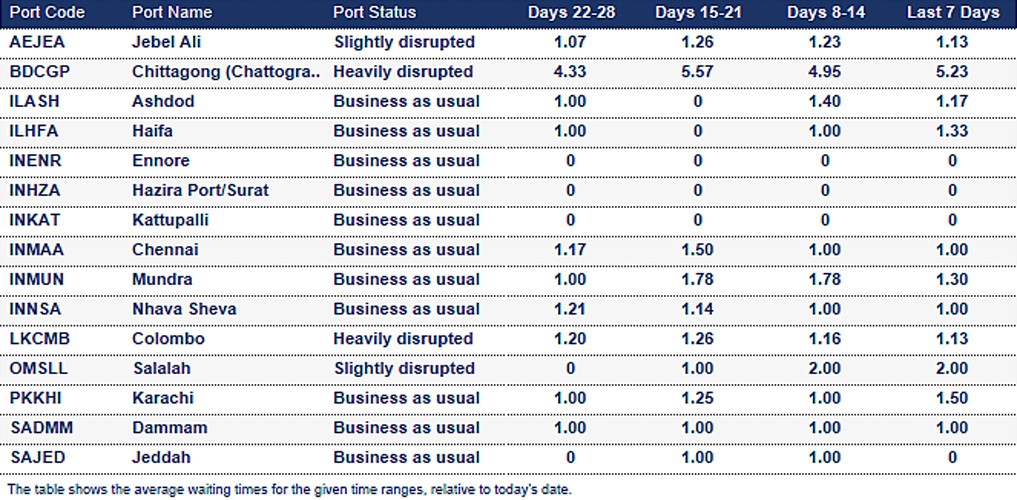
Bangladesh
Chittagong: Kuehne+Nagel reports no changes in the situation in Chittagong. Both the berth and container yards are congested. Vessels wait, on average, 6- 9 days for a berth and remain in port for 3-4 days.
Due to limited terminal productivity, most vessel working time is spent on discharge rather than loading, leading to heavy congestion in the yard. At the time of publishing, 16 vessels were at anchor. The monsoon is active over Bangladesh and can result in heavy rainfall, flooding and operational disruptions.
Sri Lanka
Colombo: The number of waiting vessels has increased to 13 this week, twice the number compared to last week. Monsoon weather can interrupt operations. Colombo remains congested, and transhipments can face a 1- 2 week delay.
North America
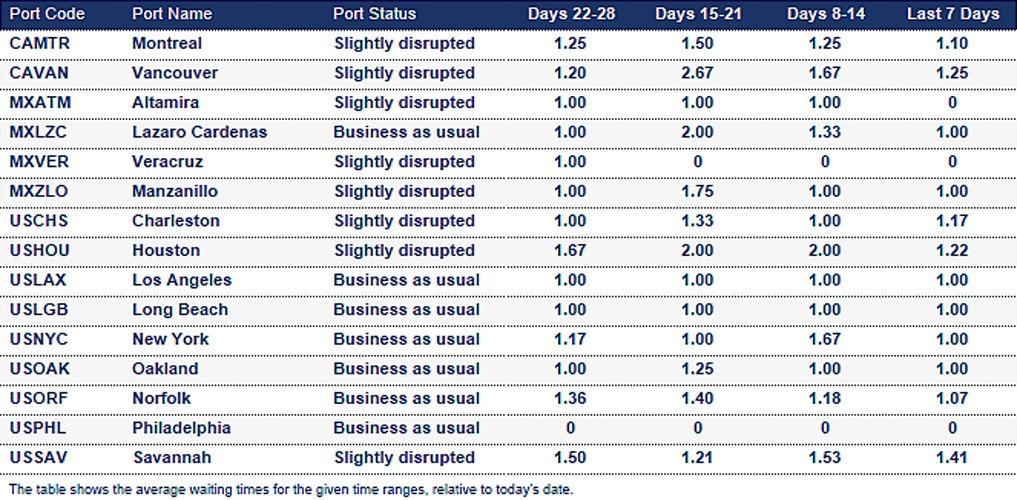
Canada
Average import rail dwell time for Canadian cargo:
- Halifax: 5 days
- Montreal: 9 days
- Prince Rupert: 4 days
- Saint John: 7 days
- Vancouver: 9 days
Mexico
Due to strikes weeks ago and bad weather that has limited recovery, Manzanillo is severely congested. The port is working on a FIFO basis for vessels. Berthing delays can be up to four days.
At Gulf ports, Altamira and Veracruz operations are stable but susceptible to disruptions during the Hurricane season. Berthing delays can be up to 3 days.
For cargo to/from Altamira, the landslide at PK-156 on the M line in Linares no longer affects train movement. Altamira export delays are now down to 72 hours, and imports face delays of 48 hours, down from 72 hours last week.
USA
Average import rail dwell and transit time for US cargo (Vessel arrival to departure rail ramp):
- Montreal: 5 days
- Prince Rupert: 4 days
- Vancouver: 5 days
- Charleston: 2 days
- Houston: 5 days
- Jacksonville: 2 days
- Los Angeles: 6 days
- Long Beach: 6 days
- New York: 5 days
- Norfolk: 3 days
- Savannah: 1 day
Charleston: Some vessels can wait up to 3 days for a berth.
South and Central America
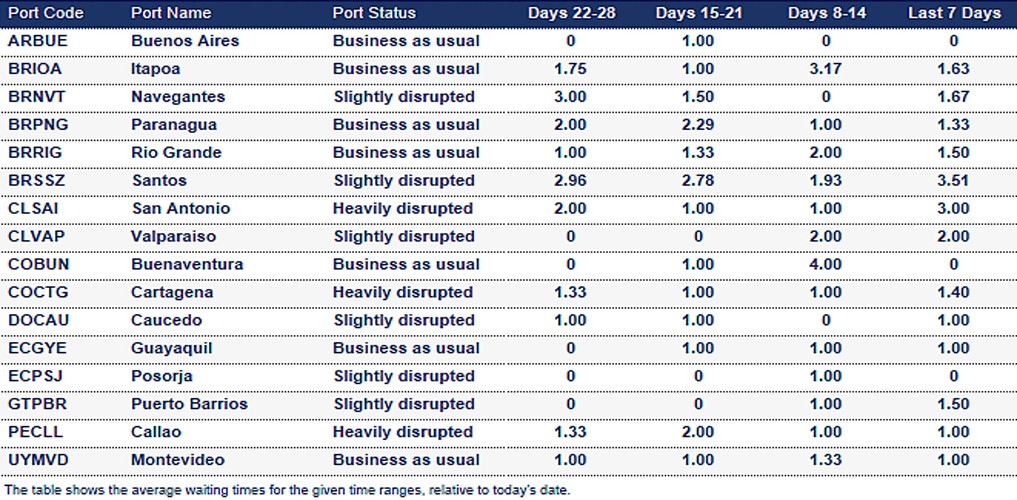
Colombia
July is the peak export period for agricultural products to North America and Europe. High volumes challenge operations at Catagena, resulting in delays in transhipment cargo. At the time of publishing, six vessels were waiting for a berth.
Costa Rica
Caldera: The 7-day average vessel waiting time is around 8 days. The port is currently congested, and the infrastructure is not able to cope with the volume influx, leading to fluctuating levels of disruptions.
Puerto Moin: The APM Terminal Moín is currently experiencing significant congestion, which is causing operational challenges such as difficulties in scheduling and coordinating shipments and delays in the movement of import and export containers.
Customers may experience longer transit times and delays in receiving their shipments. The terminal has implemented several mitigation measures, but various external factors continue to pose challenges.
El Salvador
Acajutla: The 7-day average vessel time is around 7 days. However, terminal congestion has improved slightly and is now around 60%.
Guatemala
Due to the increased volume of cargo passing through Guatemala, there is a truck shortage for cargo to/from Honduras, Nicaragua, and El Salvador.
Puerto Barrios: The yard is experiencing high levels of utilisation at around 88%, primarily due to service reliability issues and a shortage of truck drivers. These factors are adversely affecting the timely release of import cargo.
Puerto Quetzal: The 7-day average vessel waiting time is around 2 days. The port is congested at around 86%.
Puerto Santo Tomas de Castilla: The yard is experiencing high levels of utilisation, and the infrastructure is not able to cope with the high volumes. The limited terminal capacity and the slow pace of import releases are affecting export volumes.
Honduras
Puerto Cortes: Carriers report waiting up to 7 days for a berth and departing the port with a week's delay. The port is challenged by a doubling of volume due to seasonal commodity increases, a high number of red-selective inspections, and limited customs personnel on-site.
For imports, a 48-hour advance notice is required to manage and ensure container departure. Exports require a minimum of 2 weeks' advanced notice. The yard is congested at around 101%.
Jamaica
Kingston: The 7-day average vessel waiting time is around 3.5 days. The port is severely affected by vessel bunching. On-window vessels berth on arrival, while off-window ships can wait up to 7 days. Due to high volumes, transhipment cargo is facing delays. The yard is heavily congested.
Nicaragua
Corinto: The 7-day average vessel waiting time is around 3 days, and yard density is high. Vessels can wait up to 10 days before operations can begin at the port.
Panama
Balboa: The yard utilisation is at around 85%. Congestion is currently moderate, with some delays in landside dispatch due to the build-up of transhipment containers.
Cristobal: The 7-day vessel waiting time is around 2.7 days due to congestion.
Manzanillo: The 7-day average vessel waiting time is around 1 day. The yard occupancy can reach up to 85%. Congestion levels are currently high, with operational bottlenecks observed in the yard and significant delays affecting the dispatch of land cargo.
Peru
Callao: The 7-day average vessel waiting time is around 1 day. Severe congestion on primary access routes to APM and DPW terminals—worsened by recent road closures near the Port of Callao—has led to a 50–65% reduction in cargo throughput, significantly disrupting import/export operations.
Persistent access challenges have resulted in truck entry delays of up to 12 hours. APM Terminals is most affected, due to ongoing Phase 3A modernisation works at the North Terminal.
How Kuehne+Nagel calculates the 7-day average vessel waiting time
Mainline container vessels may spend a certain number of days waiting at designated anchorage areas before their scheduled port call.
To calculate the 7-day average waiting time, we consider the waiting days of these vessels, excluding:
- Waiting times for feeder vessels,
- Idle ships without an announced next port,
- Slow steamers heading toward the anchorage but not actively waiting within the designated area
- Vessels passing through the anchorage area without intending to call at the port.
This rolling average is based on the data from the last seven days and is updated daily in seaexplorer.
To find the latest waiting time for a port, enter the port name or code in the search bar and select the relevant option.
Stay Ahead Stay Informed: Register for seaexplorer for the latest disruptions and vessel waiting times at global container ports.


